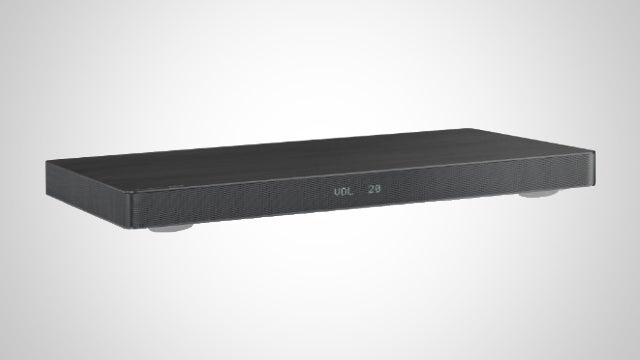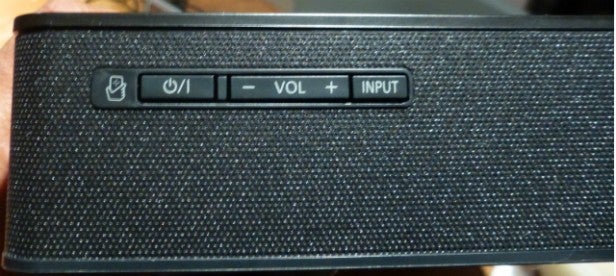Panasonic SC-HTE180 Review
Panasonic SC-HTE180 Review
A neat and tidy speaker board that brings largescale sound without the clutter

Verdict
Pros
- Discreet yet attractive styling and solid build quality
- Dynamic, room filling sound with good volume and crisp detail
- Generous connections and sound modes
Cons
- Bass lacks agility and precision
- Not as detailed as certain rivals
- Front panel menus a little slow to respond
Key Specifications
- Review Price: £349.95
- Two integrated 8cm subwoofers and two 3.8 x 9cm cone drivers
- 120W power output
- Bluetooth with NFC
- Dolby Digital and DTS decoding
- Works with Panasonic Music Streaming app
What is the Panasonic SC-HTE180?
The SC-HTE180 is Panasonic’s latest ‘speaker board’, a larger version of the SC-HTE80 launched last year. If you don’t know what a speaker board is, it’s like a soundbar except that you put your TV on top of it, creating a tidy, space-saving audio solution. All the speakers, amplifiers and processors you need are built into its flat slimline chassis, ruling out the need for space-hogging speakers and cluttersome cables.
Other companies call them soundbases, plinths or soundplates, but whatever the name they share a common goal – to improve the notoriously naff sound quality from slim TVs. However, this effort from Panasonic boasts more features and connections than most rivals, and if audio performance improves on the SC-HTE80 then we could have a winner on our hands.
You may also like:
- ROUND-UP: Best Soundbars
- REVIEW: LG SoundPlate LAP340

Panasonic SC-HTE180 – Design and Connections
The whole point of a soundbase is that it becomes part of the furniture, assimilating discreetly into its surroundings. On that level the SC-HTE180 succeeds. The understated black styling blends with our black TV perfectly (there’s a silver version too) while the slender 60mm height and lack of front panel clutter ensure your eyes aren’t drawn away from the TV screen.
But that’s not to say it’s not well designed. The curved corners add elegance and the top panel sports a stylish brushed finish. Build quality is also impressive – the bodywork is strong and sturdy, supporting TVs between 42 and 50in with no fuss (up to 50kg in weight) and it side-steps the overly plasticky feel that often blights Panasonic products.
The front edge plays host to an LED display, which gives out vital information like volume levels and selected inputs. It also displays the surprisingly involved setup menu. On the right hand side is a small cluster of buttons controlling volume, input and power.

The SC-HTE180 offers a generous selection of sockets on the back, chief among which are the HDMI input and ARC-compatible output. These allow you to send audio signals to the Panasonic while passing hi-def pictures through to your TV. It won’t pass through 4K signals – that talent is reserved for the top-end SC-HTB880 – but it does handle 3D.
The HDMI ports are joined by an optical digital audio input – the socket of choice if you want a simple single-cable connection to your TV – and analogue stereo RCA input. There’s also a USB port for service use only.
Panasonic SC-HTE180 – Features
The SC-HTE180 is equipped with two integrated downward-firing subwoofers and two 3.8 x 9cm cone drivers at the front. Airflow is managed through two ‘Aero Stream’ ports on the back of the unit. Onboard amplification is quoted at 120W.
Panasonic describes the SC-HTE180 as having ‘Smart Networking’ but that basically means there’s built in Bluetooth 3.0 with NFC for easy one-touch pairing with Android smartphones.
The smart bit is Panasonic’s Music Streaming App, which provides a way of managing and controlling wireless playback, although we’re not sure what advantage this has over streaming via Bluetooth in the normal way. However, you do need to install it before using NFC. Sadly there’s no Bluetooth apt-X for enhanced sound quality, unlike the Canton DM50.
Panasonic also throws in its usual generous gamut of sound modes for you to play with. These include six fairly self-explanatory audio presets – Standard, Stadium, Music, Cinema, News, Stereo – and four subwoofer levels which incrementally increase bass intensity. H-Bass boosts it even further.
Dolby Virtual Speaker attempts to recreate a surround effect while Panasonic’s own 3D Surround mode enhances its effects further by expanding the sound in every direction. Both are activated by default unless you select the Stereo preset.
You also get four Dialog settings that enhance speech frequencies, while 3D Clear Mode Dialogue tries to make everything sound like it’s emerging from the screen. On board decoding includes Dolby Digital and DTS.
Panasonic SC-HTE180 – Operation
 The
The
SC-HTE180 takes minutes to setup and is blissfully simple to use. The
front LED display makes it easy to explore the sound settings and setup
menu, spelling out options in large letters and scrolling to reveal
longer sentences. It’s much easier than relying on flashing lights and
icons, as some soundbases do.
The compact remote is destined to
spend most of its life down the back of the sofa but it’s easy to use.
The rubber buttons are sensibly arranged and clearly labelled. There are
separate keys to access the Setup and Sound menus, with up, down and OK
buttons for moving through them.
The Setup menu offers dimmer,
auto power, volume limitation, Bluetooth standby and Viera Link options.
As well as the sound modes listed on the previous page, the Sound menu
features Dual Audio, Auto Gain Control and Low Volume Mode options. It’s
easy to follow but a tad unresponsive, with a slight delay when you
press a button.
Panasonic SC-HTE180 – Performance
Despite
using the same drivers and subwoofers as the smaller SC-HTE80, the
SC-HTE180 delivers a more satisfying sound overall – although it still
falls short of the best soundbases.
Firstly, the good stuff. It
achieves an impressive sense of scale for such a slender unit, thanks to
the combination of loud volume, rich bass and wide effects dispersion.
So when we fired up Wrath of the Titans on Blu-ray, its epic action
scenes sound suitably exciting, plus its big soundstage does justice to
the giant monsters lumbering around the screen.
As two-headed
fire-breathing beasts wreak havoc in Perseus’ village, weighty
explosions and roaring jets of fire fill the room, while the front
speakers briskly disperse midrange and treble. There’s enough bite to
make everything sound dynamic, but it never strains the ears, even at
loud volumes.
And
like its little brother, the SC-HTE180 renders dialogue with terrific
clarity, but with so many dialog settings on board we’re really not
surprised. You don’t miss a single line, even when the Gods are dishing
out their noisiest form of vengeance.
The SC-HTE180 does a fine
job with high frequencies too, pulling out enough detail to make scenes
sound crisp and open. You can hear the tinkle of chains and the crunch
of sandals on gravelly desert floors, although the Canton DM50
renders these effects with even greater clarity and refinement. Up
against this polished performer – which uses a three-way system with
separate tweeters, midrange drivers and subs – the Panasonic sounds
comparatively compressed.
One thing worth noting here is that you
must keep 3D Clear Mode Dialog activated at all times, especially when
watching movies. It makes the soundstage wider, fuller and more
detailed, but turn it off and the sound is flat, narrow and quieter.
In
terms of bass performance, the SC-HTE180 offers an improvement over its
little brother, which we criticised for a lack of low-end oomph. Here,
the larger cabinet delivers better depth and solidity when the scene
demands it, but it lacks the agility and precision needed to make
transients really hit home – what you get is more of a nebulous rumble.
We also recommend having a thorough play with the sub level and H.Bass
settings to find the optimal balance, as bass can quite easily become
overpowering.
Stream music to the SC-HTE180 via Bluetooth and the
results are enjoyable. Decent detail, depth and vocal clarity make
songs sound easy on the ear, although if you’re serious about music you
might be better off checking out a proper hi-fi solution like the Q Acoustics Q-BT3.

Should I buy the Panasonic SC-HTE180?
Although
the SC-HTE180 is an impressive proposition in many respects, it’s not
the best-sounding speaker board for the money – and for many, that’s the
bottom line. The similarly-priced Canton DM50 offers better detail, bigger, punchier bass and a more polished sound overall.
But
on the plus side, the Panasonic offers a more generous range of
features, connections and sound modes, plus its stylish design will be a
real winner in any living room – and that might be reason enough for
you to give it a whirl despite the quality of the competition.
Verdict
The
SC-HTE180 is a stylish, easy-to-use soundbase with plentiful sockets
and sound modes, but it’s pipped to the post on sound quality by its
more polished rivals.
Next, read our pick of the Best Soundbars and Soundbases
Trusted Score
Score in detail
-
Performance 8
-
Features 9
-
Value 8
-
Sound Quality 8
-
Design 8
Features
| 3D Ready | Yes |
| Number of Speakers | 4 |
| Supported Channels | 2.1 |
| DVD Player | No |
| Blu-ray player | No |
| Audio Processing | Dolby Virtual Speaker |
| Dolby Digital | Yes |
| DTS | Yes |
| Dolby Pro Logic II | Yes |
| Dolby TrueHD | No |
| DTS Master Audio HD | No |
Connectors
| HDMI Input | 1 |
| HDMI Output | 1 |
| S/PDIF Optical In | 1 |
| Stereo Line In | 1 |
| Power (Watt) | 120W |
Physical Specifications
| Height (Millimeter) | 60mm |
| Width (Millimeter) | 700mm |
| Depth (Millimeter) | 365mm |
| Weight (Gram) | 4.5kg |


